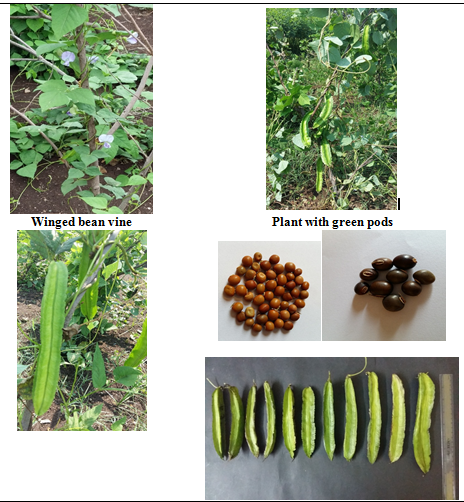Authors: Dinesh Chand, Smita Shingane, Sunil Gomashe, Nilamani Dikshit and Jameel Akhtar
Winged bean (Psophocarpus tetragonolobus) is edible legumes originated in tropics known for their protein-rich pods and seeds. It is mainly grown in different parts of the Philippines, Indonesia, and Malaysia. In India it is specifically grown in the north eastern states, West Bengal, Orissa and few Southern states. It is also known as Asparagus pea, cornered bean, Manila bean, Mauritius bean, dragon bean, Goa bean etc. These are members of Fabaceae family, climbers twinning vines having diversified uses. Winged bean produce a glabrous four-angled pods. It grows very well in hot and humid climate of tropics which has short days, high moisture and well drained soils. Flowering usually starts after 45 days from planting and give rise to white, pink or light blue colour. Almost all plant parts (tender pods, mature seeds, tender leaves, shoots and tubers) are used in East Asian Cuisine.
Winged bean vines usually grows up to 5m in height and has luxuriant leafy growth. It produces tender green pods which can be of up to 50 cm length and are utilized as raw salad, in soups and curry preparations. The matured pods are best used by boiling, as fried stuff or roasted. Most of places it is not grown as a commercial crop and mostly confined kitchen gardens. Winged bean seeds are also utilised as animal feeds in ruminant and poultry industry due to their high protein content up to 39%.
Tubers of winged bean are high in starch content and has nutty flavour and contain about 20% proteins. These also contain oxalates so care need to be taken by the individuals having history of urinary stones as these oxalates tend to crystalize can form urinary stones.
In addition to various nutritional and medicinal uses winged bean these are also beneficial for cultivation because of its nitrogen fixing ability. Leaves also add a significant amount of organic matter to the soil during the period of cultivation.
Important Nutritional components in winged bean:
Carbohydrate and proteins: These are mainly low-calorie veggies about 100 g beans has only 49 calories. On the contrary mature winged seeds has 409 calories 100g-1. Seeds contain relatively high percentage of protein which is almost equivalent to soybean protein.
Folates: Winged bean when fresh supply a good amount folate (66ug/100g) which is 16.5% of the daily requirement. For DNA synthesis and cell division folate and vitamin B12 are the essential components. These are highly required for normal development of new born babies during pregnancy period.
Vitamin -A, -B and -C: Winged bean leaves are rich in vitamin-A 8090 IU (per 100g) and vitamin- C (45mg/100g) which are essential for improved vision and high antioxidant activity, respectively. Vitamin-C is also required for strengthening immunity against various diseases. In addition to this green leaves are good source of fibre and minerals (as iron, copper, manganese, calcium, phosphorus, magnesium etc.). Leaves and tubers of winged bean are rich in starch, Proteins and B-complex vitamins as compared to potato and cassava.

Variability for pod length, width and shape in winged bean
Considering it high nutritional value and perennial nature research efforts are needed to promote its commercial cultivation so as provide a new option to the farmers for the diversification of the existing cropping system. While exploring this a well-planned strategy is need of the hour to assess the demand and supply scenario so as get maximum benefit out of the commercial cultivation of the winged beans. Future efforts are required to find more and more diversified uses in nutrition and pharmaceutical industries to boost up the demand.
Disclaimer: The information given in the above article regarding nutritional compositions and various uses of Winged bean is merely a compilation of information from various research articles, web pages and books available online. Authors are not responsible for the medicinal or any other use reported here
About Author / Additional Info:
I am working as Senior Scientist (Economic Botany & PGR)